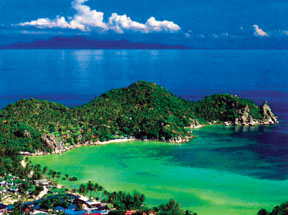
Lagoons around the coastal line
You may have heard of lagoons. Living in an island, lagoons are
nothing unusual for us. In Sri Lanka, lagoons are found in Batticaloa,
Negombo, Puttalam and Rekawa, among other areas. So, what exactly is a
lagoon?
Lagoons are shallow coastal bodies of water separated from the ocean
by a series of barrier islands which lie parallel to the shoreline. In
simple terms, an area of relatively shallow, quiet water with access to
the sea, but separated from it by sandbars, barrier islands, or coral
reefs is called a lagoon. Inlets (strips of water cutting into land),
either natural or man-made, cut through barrier islands and permit tidal
currents to transport water into and out of the lagoons.

Because lagoons are characteristically shallow, they are strongly
influenced by precipitation (moisture from vapour) and evaporation (turn
into vapour), which result in fluctuating (changing) water temperature
and salinity (salt content). Lagoons can also be fragile (sensitive)
ecosystems open to pollution effects from municipal, industrial and
agricultural runoff. Lagoon refers to both coastal lagoons formed by the
build-up of sandbanks or reefs along shallow coastal waters, and the
lagoons in atolls, formed by the growth of coral reefs on slowly sinking
central islands.
Coastal lagoons are usually found on coasts with relatively small
tidal ranges. They comprise 13 per cent of all coastlines. They
generally extend parallel to the coastland, separated from the sea by
barrier islands, sand and shingle (pebble) bars or coral reefs.
Non-reef lagoon barriers are formed by wave-action or longshore
currents piling up coarser (rough) sediments offshore of the beach. Once
a lagoon barrier has formed, finer sediments can settle out in the
relatively quiet water behind the barrier, including sediments brought
into the lagoon by rivers.
Coastal lagoons typically have only constricted (tight) openings to
the sea. As a result, water conditions in the lagoon can differ
significantly from the open water of the sea, in temperature, salinity,
dissolved oxygen and sediment load.
Lagoons are classified into three main types: leaky lagoons, choked
lagoons, and restricted lagoons. Leaky lagoons have wide tidal channels,
fast currents and unimpaired (without restrictions) exchange of water
with the ocean. Choked lagoons occur along high energy coastlines and
have one or more long narrow channels which restrict water exchange with
the ocean.
Circulation within this type of lagoon is dominated by wind patterns.
Restricted lagoons have multiple channels, well defined exchange with
the ocean, and tend to show a net seaward transport of water. Wind
patterns in restricted lagoons can also cause surface currents to
develop, thus helping to transport large volumes of water downwind. The
Indian River Lagoon is a restricted type lagoon.
****
What is an atoll?
A coral reef enclosing a lagoon is called an atoll. Atolls consist of
ribbons of reef that may not be circular, but that are closed shapes,
sometimes miles across, around a lagoon that may be 160 ft (50 m) deep
or more.
Most of the reef itself is usually below the water surface; around
the rim along the top are usually low, flat islands or more continuous
strips of low, flat land.
Mineral composition of the Dead Sea
The mineral content of the Dead Sea is significantly different from
that of ocean water, consisting of 53 per cent magnesium chloride, 37
per cent potassium chloride and 8 per cent sodium chloride (salt), with
the remainder comprising various trace elements.
The concentration of sulphate, SO42-, ions (electrically charged
particle)is very low, and the bromide ion concentration is the highest
of all waters on Earth.
Chlorides neutralise most of the calcium ions in the Dead Sea and its
surroundings. While in other seas, sodium chloride (NaCl) accounts for
97 per cent of the salts, in the Dead Sea, the quantity of NaCl is only
12-18 per cent. The water temperature varies from 19 degrees Celsius in
February to 31 degrees Celsius in August.
Comparisons between the chemical composition of the Dead Sea to other
lakes and oceans show that the salt concentration in the Dead Sea is
31.5 per cent (the salinity fluctuates somewhat). Because of its
unusually high concentration of salt, anyone can easily float in the
Dead Sea because of natural buoyancy (ability to float) as a result of
the higher density of the water.
In this, the Dead Sea is similar to the Great Salt Lake in Utah,
United States. The water of the Dead Sea has a greasy feel to it. The
water stings, and causes pain if it comes in contact with the eyes. One
of the most unusual properties of the Dead Sea is its discharge of
asphalt.
From deep seeps, the Dead Sea constantly spits up small pebbles of
the black substance. After earthquakes, chunks as large as houses may be
produced. The sea is called "dead" because its high salinity means no
fish or aquatic organisms can live in it, though minuscule (very small)
quantities of bacteria and microbial fungi are present.
In times of flood, the salt content of the Dead Sea can drop from its
usual 35 per cent salinity to 30 per cent or lower. In the wake of rainy
winters, the Dead Sea temporarily comes to life.
In 1980, after one such rainy winter, the normally dark blue Dead Sea
turned red. Researchers from the Hebrew University found the Dead Sea to
be teeming with a type of algae called Dunaliella.
The Dunaliella, in turn, nourished carotenoid-containing
(red-pigmented) halobacteria whose presence was responsible for the
colour change. Since 1980, the Dead Sea basin has been dry and the algae
and the bacteria have not returned in measurable numbers. |


